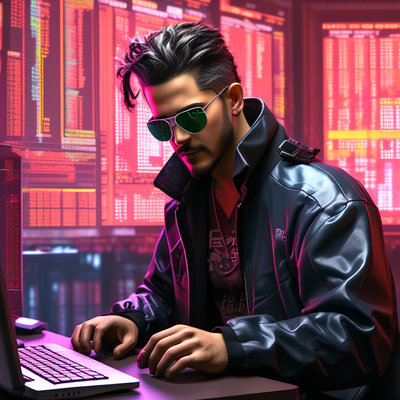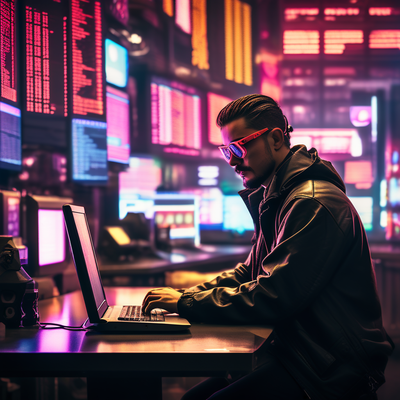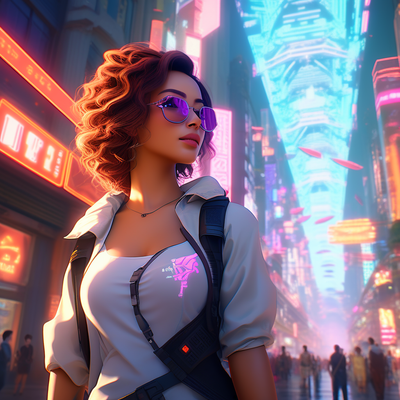hacking : the cyberpunks of the digital age
Code, Creativity, Cyberpunk: Redefining Hacking in the Digital Age



In the sprawling digital landscapes of our time, hacking has transcended its former image of shadowy activities in the realms of cyberspace. It has evolved into an art form, a profound expression of creativity and technical mastery, embraced by a new generation of digital artists: the cyberpunks of the digital age. Hackers emerged as the quintessential anti-heroes, individuals wielding their technical prowess to navigate, manipulate, and sometimes subvert the omnipresent technological systems.
In the hands of cyberpunks, hacking becomes an art form, a means of creative expression. These modern-day digital artists use their skills to make political statements, challenge corporate power structures, and advocate for privacy and freedom in the digital world. Their work often involves the subversion of standard technologies to create something new and unexpected, much like an artist uses a canvas to bring their vision to life.
The art of hacking in the cyberpunk world is not just about the act itself but also about the aesthetic that accompanies it. This involves a fusion of technology and art, where code becomes poetry and computer terminals turn into canvases. The visual language of cyberpunk hacking is rich with neon lights, graphical interfaces, and futuristic motifs, creating a vivid and immersive experience.
The influence of cyberpunk hacking extends into popular culture, where it has been popularized and romanticized in movies, books, and video games. From the Matrix's Neo to Mr. Robot's Elliot Alderson, these characters embody the hacker as a digital warrior, a symbol of resistance against oppressive systems in a high-tech world.
As we move further into the digital age, the art of hacking is set to evolve in ways we can't yet imagine. With advancements in artificial intelligence, quantum computing, and virtual reality, the tools and canvas for these digital artists will expand, offering new horizons for creative expression and technological innovation.
In the digital age, hacking has emerged as a significant form of artistic and cultural expression. The cyberpunks of our time have redefined what it means to be a hacker, blending technical skill with creativity and vision. Their work challenges our perceptions, pushes the boundaries of technology, and continues to shape the landscape of digital culture. In the art of hacking, we find not just a skillset, but a form of expression that is uniquely suited to our times, a vibrant testament to the human spirit's resilience and ingenuity in the face of an ever-evolving digital world.
The awesomeness of a hacking cyberpunk artist lies in their unique blend of technical mastery and creative innovation. These digital rebels navigate the complex labyrinths of cyberspace with the dexterity of a seasoned coder, while also embodying the spirit of an artist, using their skills to challenge conventions and redefine the boundaries between technology and art. Their work is not just about breaking into systems; it's about breaking new ground, transforming the binary world of code into a medium for profound expression and impactful social commentary. In the realm of cyberpunk, they are the modern-day magicians, turning the virtual landscape into a canvas of limitless possibilities.
Cyberpunk Canvas: Painting the Future with Hacking Artistry
--
In the shadowy neon-lit alleys of cyberpunk fiction, characters navigate a world where technology and the human mind intertwine, blurring the lines between reality and digital illusion. This narrative, however, is not confined to the realm of speculative fiction. Today, we stand at the precipice of a new era, where the cyberpunk ethos of hacking, combined with insights from the psychedelic movement and metaphysical philosophies like the Seth Material by Jane Roberts, offers revolutionary pathways for personal transformation and reality manipulation. Cyberpunk, with its roots deeply embedded in the ethos of subversion and resistance against centralized powers, presents reality as a complex system that can be hacked, manipulated, and ultimately controlled. This perspective mirrors the Seth Material's fundamental principle that individuals create their own reality through their beliefs, emotions, and expectations. The convergence of these views provides a potent framework for exploring how we can manipulate our perception of reality using technology and altered states of consciousness.
The advent of VR and AR technologies has opened new vistas for exploring and manipulating the fabric of reality. These digital realms offer safe, controllable environments where individuals can experiment with different aspects of their psyche, confront fears, or practice new behaviors. By immersing themselves in these virtual worlds, users can leverage the plasticity of their brains to effect lasting changes in their perception and interaction with the external world, a concept reminiscent of the reality creation philosophy detailed by Seth.
AI technology, with its capacity for deep learning and environmental simulation, can act as a modern-day shaman, guiding individuals through personalized journeys of self-discovery and reality manipulation. Through biofeedback, AI can tailor psychedelic-like experiences in VR settings, inducing states of consciousness that facilitate profound insights into the nature of reality and the self. This symbiosis of AI and human consciousness echoes the cyberpunk vision of technology as an extension of the human mind, capable of unlocking new dimensions of understanding.
The field of neurohacking applies the cyberpunk ethos directly to the human brain, employing nootropics, transcranial direct current stimulation (tDCS), and other neurotechnologies to enhance cognitive function, mood, and perception. By altering the brain's chemistry and electrical patterns, individuals can "reprogram" their mental states, aligning them more closely with desired realities. This approach aligns with the Seth Material's assertion that beliefs mold reality, suggesting that changing the brain's wiring can change one's experience of reality.
The integration of psychedelic experiences with cybernetic technology represents a frontier in mind hacking. Psychedelic substances can dissolve the boundaries of the ego, offering glimpses into alternate realities and deeper truths about the self and the universe. When combined with cybernetic feedback loops, these experiences can be guided and amplified, providing a controlled environment for exploring the malleable nature of reality. This technique embodies the essence of reality manipulation, merging the biochemical with the digital to unlock new realms of consciousness.
As we venture further into the synthesis of cyberpunk techniques, psychedelics, and reality creation philosophy, ethical considerations become paramount. The power to manipulate reality, whether through technology or altered states of consciousness, carries with it a responsibility to respect the autonomy and well-being of the individual. The potential for misuse underscores the need for a collective dialogue on the direction and limits of these practices.
The future of mind hacking, inspired by cyberpunk and underpinned by philosophies like that of Seth, promises a new era of personal empowerment and transformation. By embracing these techniques, we can explore the vast landscapes of consciousness and reality, pushing the boundaries of what it means to be human in an increasingly digital world. The journey ahead is fraught with challenges, but it holds the promise of unveiling deeper truths about ourselves and the universe we inhabit.
CYBERPUNK FUTURE!
(this text is generated by Chat GPT)
In the hands of cyberpunks, hacking becomes an art form, a means of creative expression. These modern-day digital artists use their skills to make political statements, challenge corporate power structures, and advocate for privacy and freedom in the digital world. Their work often involves the subversion of standard technologies to create something new and unexpected, much like an artist uses a canvas to bring their vision to life.
The art of hacking in the cyberpunk world is not just about the act itself but also about the aesthetic that accompanies it. This involves a fusion of technology and art, where code becomes poetry and computer terminals turn into canvases. The visual language of cyberpunk hacking is rich with neon lights, graphical interfaces, and futuristic motifs, creating a vivid and immersive experience.
The influence of cyberpunk hacking extends into popular culture, where it has been popularized and romanticized in movies, books, and video games. From the Matrix's Neo to Mr. Robot's Elliot Alderson, these characters embody the hacker as a digital warrior, a symbol of resistance against oppressive systems in a high-tech world.
As we move further into the digital age, the art of hacking is set to evolve in ways we can't yet imagine. With advancements in artificial intelligence, quantum computing, and virtual reality, the tools and canvas for these digital artists will expand, offering new horizons for creative expression and technological innovation.
In the digital age, hacking has emerged as a significant form of artistic and cultural expression. The cyberpunks of our time have redefined what it means to be a hacker, blending technical skill with creativity and vision. Their work challenges our perceptions, pushes the boundaries of technology, and continues to shape the landscape of digital culture. In the art of hacking, we find not just a skillset, but a form of expression that is uniquely suited to our times, a vibrant testament to the human spirit's resilience and ingenuity in the face of an ever-evolving digital world.
The awesomeness of a hacking cyberpunk artist lies in their unique blend of technical mastery and creative innovation. These digital rebels navigate the complex labyrinths of cyberspace with the dexterity of a seasoned coder, while also embodying the spirit of an artist, using their skills to challenge conventions and redefine the boundaries between technology and art. Their work is not just about breaking into systems; it's about breaking new ground, transforming the binary world of code into a medium for profound expression and impactful social commentary. In the realm of cyberpunk, they are the modern-day magicians, turning the virtual landscape into a canvas of limitless possibilities.
Cyberpunk Canvas: Painting the Future with Hacking Artistry
--
In the shadowy neon-lit alleys of cyberpunk fiction, characters navigate a world where technology and the human mind intertwine, blurring the lines between reality and digital illusion. This narrative, however, is not confined to the realm of speculative fiction. Today, we stand at the precipice of a new era, where the cyberpunk ethos of hacking, combined with insights from the psychedelic movement and metaphysical philosophies like the Seth Material by Jane Roberts, offers revolutionary pathways for personal transformation and reality manipulation. Cyberpunk, with its roots deeply embedded in the ethos of subversion and resistance against centralized powers, presents reality as a complex system that can be hacked, manipulated, and ultimately controlled. This perspective mirrors the Seth Material's fundamental principle that individuals create their own reality through their beliefs, emotions, and expectations. The convergence of these views provides a potent framework for exploring how we can manipulate our perception of reality using technology and altered states of consciousness.
The advent of VR and AR technologies has opened new vistas for exploring and manipulating the fabric of reality. These digital realms offer safe, controllable environments where individuals can experiment with different aspects of their psyche, confront fears, or practice new behaviors. By immersing themselves in these virtual worlds, users can leverage the plasticity of their brains to effect lasting changes in their perception and interaction with the external world, a concept reminiscent of the reality creation philosophy detailed by Seth.
AI technology, with its capacity for deep learning and environmental simulation, can act as a modern-day shaman, guiding individuals through personalized journeys of self-discovery and reality manipulation. Through biofeedback, AI can tailor psychedelic-like experiences in VR settings, inducing states of consciousness that facilitate profound insights into the nature of reality and the self. This symbiosis of AI and human consciousness echoes the cyberpunk vision of technology as an extension of the human mind, capable of unlocking new dimensions of understanding.
The field of neurohacking applies the cyberpunk ethos directly to the human brain, employing nootropics, transcranial direct current stimulation (tDCS), and other neurotechnologies to enhance cognitive function, mood, and perception. By altering the brain's chemistry and electrical patterns, individuals can "reprogram" their mental states, aligning them more closely with desired realities. This approach aligns with the Seth Material's assertion that beliefs mold reality, suggesting that changing the brain's wiring can change one's experience of reality.
The integration of psychedelic experiences with cybernetic technology represents a frontier in mind hacking. Psychedelic substances can dissolve the boundaries of the ego, offering glimpses into alternate realities and deeper truths about the self and the universe. When combined with cybernetic feedback loops, these experiences can be guided and amplified, providing a controlled environment for exploring the malleable nature of reality. This technique embodies the essence of reality manipulation, merging the biochemical with the digital to unlock new realms of consciousness.
As we venture further into the synthesis of cyberpunk techniques, psychedelics, and reality creation philosophy, ethical considerations become paramount. The power to manipulate reality, whether through technology or altered states of consciousness, carries with it a responsibility to respect the autonomy and well-being of the individual. The potential for misuse underscores the need for a collective dialogue on the direction and limits of these practices.
The future of mind hacking, inspired by cyberpunk and underpinned by philosophies like that of Seth, promises a new era of personal empowerment and transformation. By embracing these techniques, we can explore the vast landscapes of consciousness and reality, pushing the boundaries of what it means to be human in an increasingly digital world. The journey ahead is fraught with challenges, but it holds the promise of unveiling deeper truths about ourselves and the universe we inhabit.
CYBERPUNK FUTURE!
(this text is generated by Chat GPT)